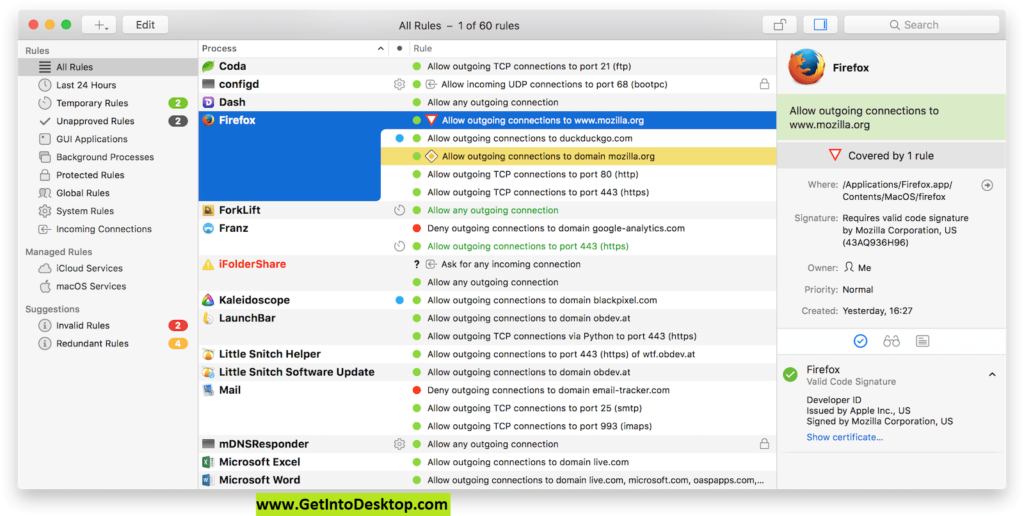

Mac’s own firewall comes with one of the best features available in network firewalls called the PF (packet filter).
LITTLE SNITCH IOS FOR MAC
Read: The Best WiFi Analyser For Mac Little Snitch Alternatives for Mac 1.
LITTLE SNITCH IOS WINDOWS
So here are some alternatives to Little Snitch for Windows and macOS. This alone can be a reason to look for alternatives that cost nothing or at least relatively cheaper than Little Snitch. But, do we really need an alternative? Well, for starters, it costs you over $40 and upgrades are extra. Sometimes DSL is available in rural areas, Starlink is another option for some, and if you have cellular service then using a dedicated Wi-Fi Hotspot with an unlimited LTE connection can be decent as well.In short, Little Snitch is one of the best apps, to keep an eye on your Mac’s Internet connections. Working with a slow rural internet connection can be tough, I know from experience.
LITTLE SNITCH IOS FREE
Ghostery is a free extension for Safari that offers that capability. You will want to know what you’re doing and blocking with those apps.Īnother option to speed up internet a bit is to use a content blocker for most of the web to stop ads and other stuff from loading (please white list sites like ours, we use ads to fund the site). Just be aware if you block some processes you might get unexpected results, ie some apps may not work, or iCloud may not work, etc. LuLu is free but a bit less UI friendly, Little Snitch is paid but is a bit easier to use. Were you able to restrict cellular data access to specific apps? Which app consumed the most cellular data on your iPhone or iPad? How many apps have you blocked so far? Do share your personal experiences and sound off in the comments section down below.įor Mac, you can block apps and processes from connecting to the internet with a firewall like LuLu or Little Snitch. Followed by video streaming apps, social networking apps can also use a lot of data depending on the content you’re browsing, so if you spend a lot of time watching clips don’t be surprised if things like Facebook, Instagram, TikTok, YouTube, and Twitter are heavy on data usage.Īnd of course there’s a privacy angle here too, perhaps you just don’t want a social networking app to be available or accessible to your location when using cellular data, and this setting can offer that option. However, this makes sure you don’t unintentionally certain demanding apps when you’re connected to LTE.Īs a general rule of thumb, any app that streams video to your iPhone will use the most internet data, especially in comparison to the rest of the apps. Of course, not launching the apps that consume a lot of internet data can help in conserving your monthly data cap. This prevents your iPhone or iPad from automatically using the cellular connection whenever your Wi-Fi connectivity is poor or slow. Disabling this feature can save some of your cellular data as well. If you scroll further down on the same menu, you’ll find a setting called Wi-Fi Assist. There you have it, you’re now limiting your cellular data to just a few apps on your iPhone or iPad. Now, you can simply use the toggle to block cellular access for apps on an individual basis. Note that they’re arranged based on how much data they’ve consumed. Here, simply scroll down until you see the list of apps that have access to your cellular data.In the settings menu, select the “Cellular” option to access your carrier network-related settings.Launch the “Settings” app from the home screen of your iPhone or iPad.The following steps are applicable regardless of what iOS/iPadOS version your device is currently running, as long as it’s vaguely new.


LITTLE SNITCH IOS HOW TO
How to Prevent Apps Using Cellular Data on iPhone & iPad So let’s take a look at how you can limit cellular data access for apps on your iPhone and iPad (cellular equipped models). Whatever the reason, you may want to limit cellular data access to specific apps, or prevent some specific apps from using cellular data. Typically, video streaming apps fall under this category, whereas instant messaging apps that you use to stay connected with your contacts use very little data in comparison. Some iPhone and iPad apps use up a lot more internet data than others too. However, unlike a Wi-Fi connection, cellular data is more expensive and often limited, even on so-called ‘unlimited’ data plans where throttling takes place past a certain consumption limit. For most users, cellular data is something that they rely on to be online when they head out of their house and have no access to a Wi-Fi network.


 0 kommentar(er)
0 kommentar(er)
